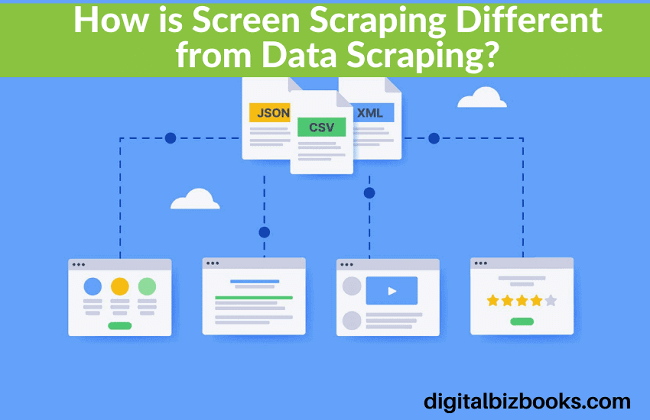Screen scraping is a type of data scraping. The difference is that it requires copying from a digital display to use it for another purpose. This is actually the extraction of visual data, which can be like a screenshot. With the help of a scraping program or manually, on-screen elements are captured. These elements can be text together with images on the desktop, in an application, or on a website.
Like data scraping, screen scraping can be ethically and unethically used. Some scammers may steal data from applications through this data collection technology. A code from another application helps them to attempt this scam.
Ethical Uses of Screen Scraping
Before understanding the difference, let’s come across the ethical uses of this technology. These are the following:
- Capturing banking application details and financial transactions
- Saving insightful data for business purposes
- Improving user experience on the basis of previous web insights
- Transform data from a legacy application or source to modern tools
- Accurately analysing various market moderators like pricing
- Analysing customer behavior and trends on the basis of online activities
How Does It Work?
There are several ways to execute screen scraping. Mostly, Java- a programming language that is used to copy and paste source codes from one application into another (which is owned by scraper). It also requires direct access to it.
Generally, this extraction method allows scraping screen display data or screenshots from specific UI elements or documents. Once collected, the data scientist or programmer can use his programming skills to exactly collect text on pages, whether formatted or unformatted.
It may be done through applications, such as Selenium or PhantomJS. These two magical languages allow users to get information from HTML in a browser. For this purpose, UNIX tools can be used as a simple screen scraper.
It’s mainly used in the banking sector. Banks allow access to a third-party app, which requests users to share their login details under strict security to access their financial transactional details. These details appear by logging into digital portals like payment gateways for transactional purposes. That app can retrieve all transactions in transit across accounts.
At the time of data transfer from a legacy program, the data scraping code or script, or tool must draw data coming from the legacy program. It is formatted for the screen of an older version of the terminal or display, which requires reformatting for Windows 10 or an updated web browser. The script or program has to reformat all inputs from the new user interfaces. It enables the legacy application to quickly handle the request.
Screen Scraping vs. Web Scraping
Screen scraping aims at extracting data on a screen. On the flip side, web scraping is all about scraping data from the website. Simply put, both processes are similar to a certain extent. But, when it comes to the location where data are extracted and used, there is a huge difference.
Precisely, web scraping is focused on drawing HTML data exclusively from the website. Contrary to it, screen extraction requires a user’s desktop or applications to scrape data. It really proves advantageous for comparing eCommerce shops, pricing, web indexing, and data mining.
This entire process is executed through HTTP over a web browser. However, it can be done manually or through a bot or web crawler.
Data Scraping
Data scraping is a type of screen extraction. It is carried out by copying data from various documents or web applications. This is a little organized process because it involves drawing structured and human-readable records using programming or scripting skills. This technique helps in exchanging records with a legacy system and making them comprehensive or readable for modern applications.
How is Data Scraping Done?
This concept is relatively older. It evolved when the World Wide Web was invented. However, the search abilities were obsolete or in the nascent stage at that time. Things changed when search engines were born. These search engines show results by navigating through a collection of File Transfer Protocol (FTP) sites. These are files where users navigate to search for a specific piece of information or file. For data extraction, it is necessary to find an organized set of data available over the internet. This command is completed through a specific automated program called the bot or web crawler. They fetch all pages on the World Wide Web and then, send a request to copy content into databases.
Over the years, the internet is rapidly improved and has become a global network of millions of web pages. These pages carry a pool of data in different forms, including texts, images, videos, and audio. This is also an open data source.
Because of housing so much information that is searchable in no time here, people have started finding desirable answers. There are millions of websites spread across the internet to respond to their queries on SERPs.
But, data scraping is still required. It is simply because every website does not have downloadable information. It created the requirement for copying either by hand or by using applications/software for data scraping. This is how web scraping came into existence, which is also supported by bots or crawlers. They function the same way as search engine bots do. They fetch and copy data similarly.
Where they differ is the scale. Web scraping requires extracting specific pieces of information from certain websites. On the other hand, search engines crawl into most of the websites on the internet.
The purpose of all of these types of scraping is similar, which is to draw information, either of a small range or massive.
Summary
Screen scraping differs from data or web scraping. However, the purpose of both processes is to extract data. But, screen extraction aims at getting on-screen data, covering text, audio, videos, etc. But, data scraping focuses on getting only a few pieces of information from specific records or documents.








